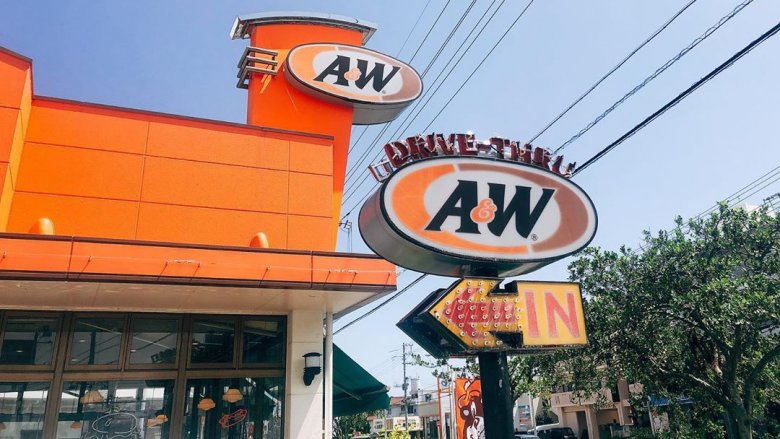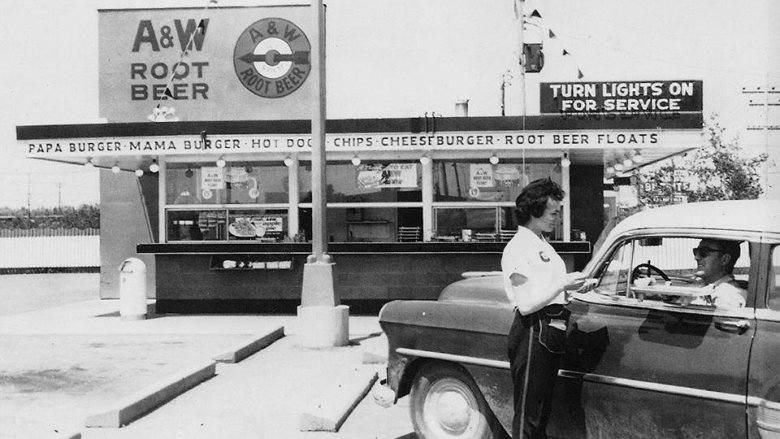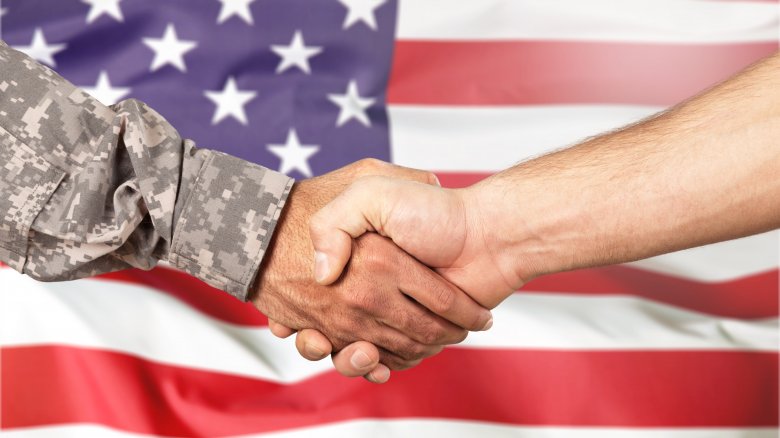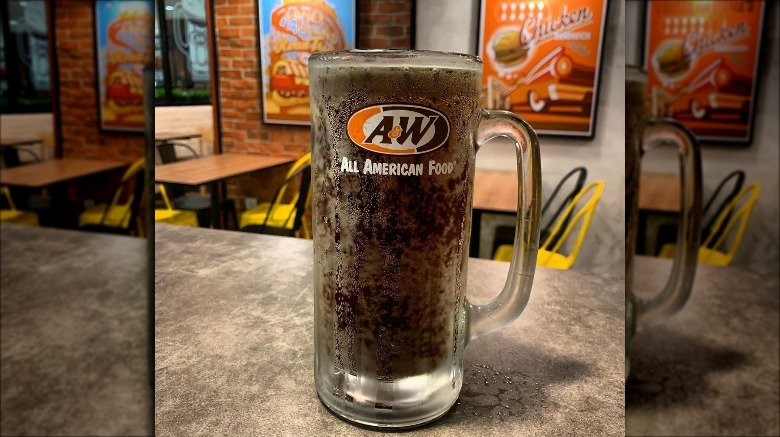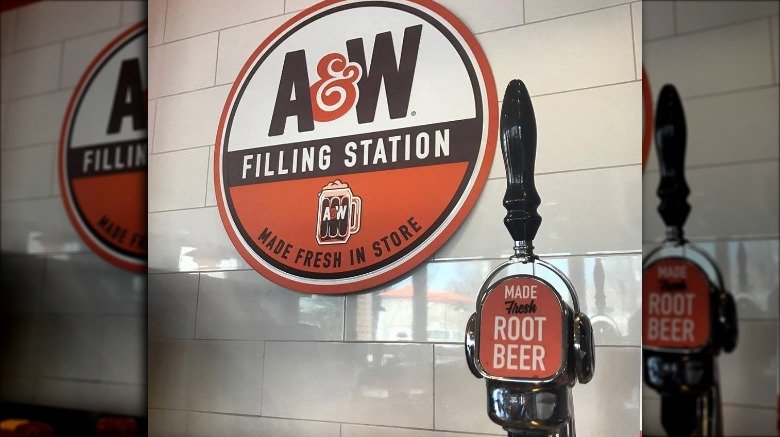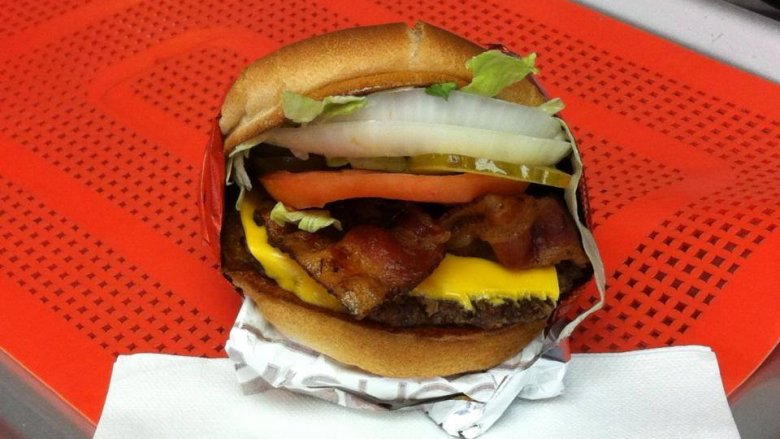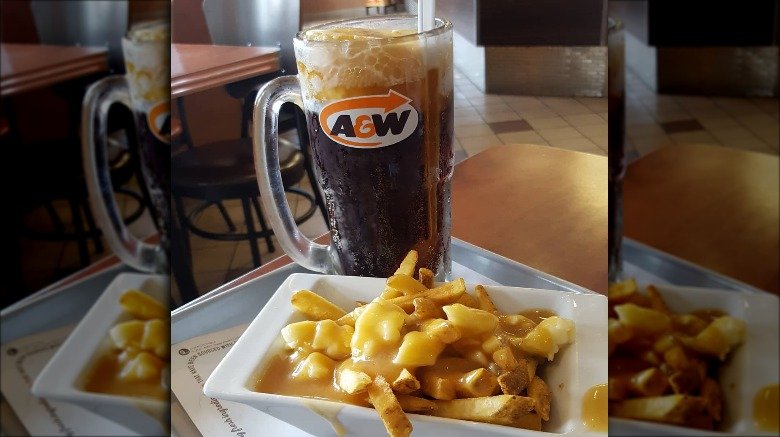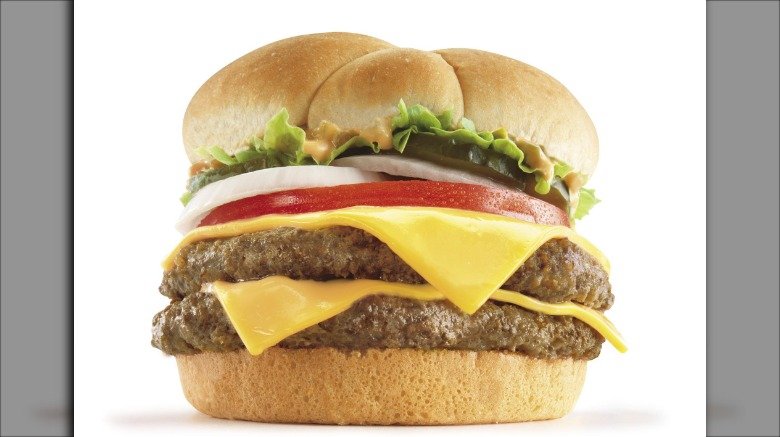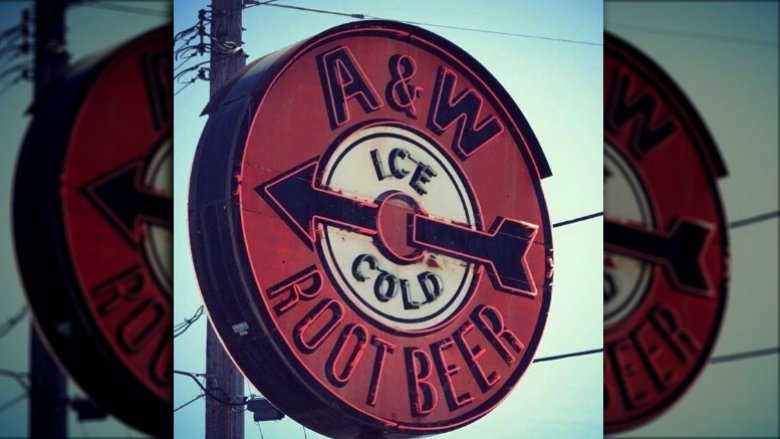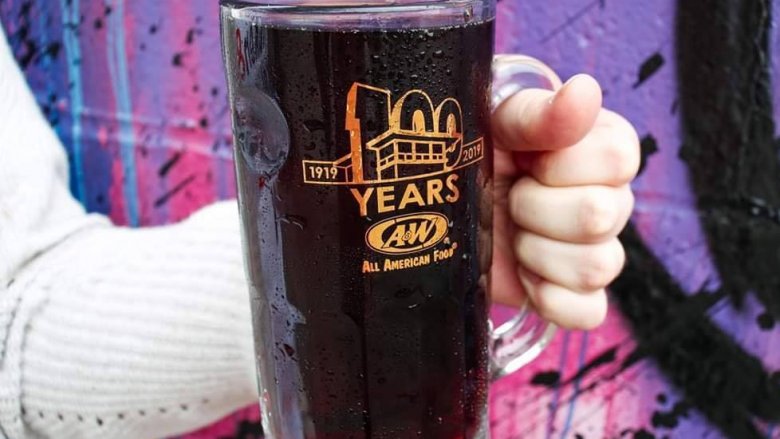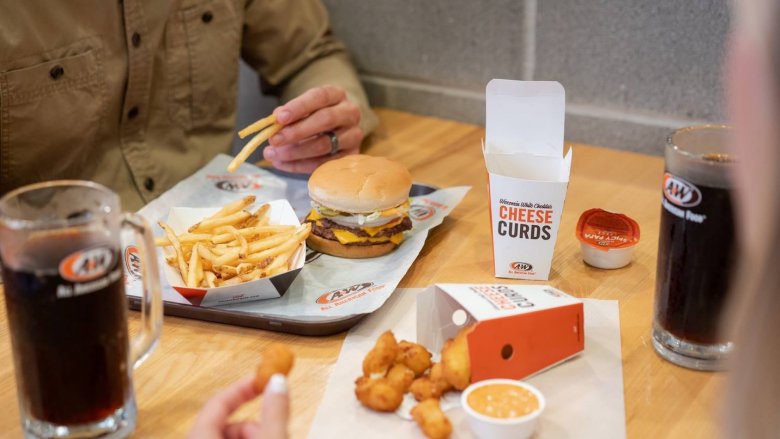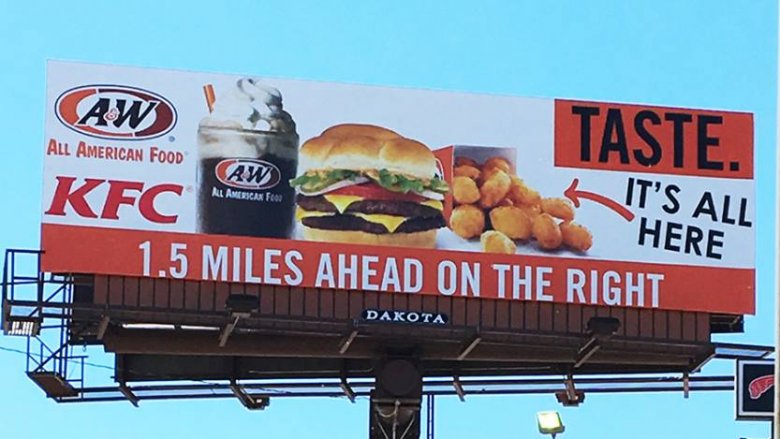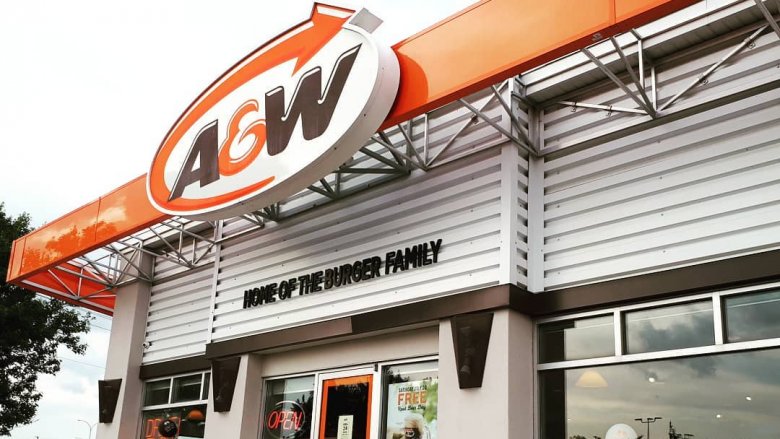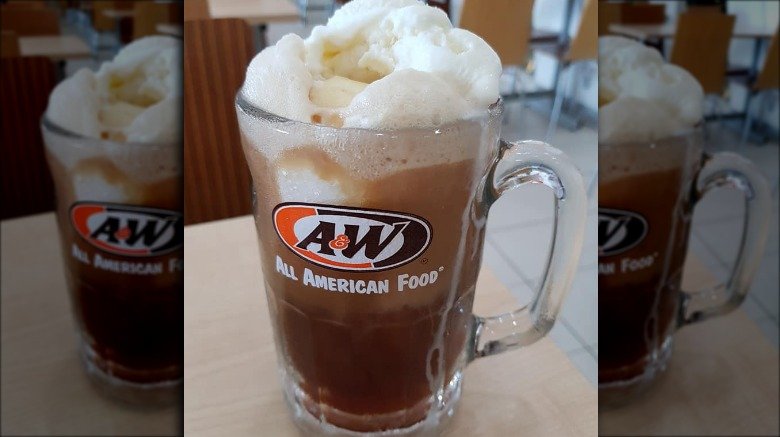The Untold Truth Of A&W
With the constant growth of fast food chains, standing out from the crowd can be tough. And while a number of chains have continued to be innovative over the years, there's one that has consistently been the go-to for root beer floats and "all American food" for 100 years.
A&W got its start from the growing popularity of root beer in the early 1900s, and the chain has continued to capitalize on its signature beverage's popularity ever since. With close to 1,000 locations throughout the world, the chain has held a steady hand in the fast food game. With a variety of burgers, chicken options, coney dogs, and the beloved root beer float on their menu, A&W has played a consistent deck of cards. And a lot can happen in 100 years.
From its relationship to prohibition, to the chain's most famous invention, there's more to A&W than meets the eye. We decided to take a closer look to learn more. This is the untold truth of A&W.
A&W was named after its founders
A&W has a long history, focused in serving people across the globe their creamy, delicious root beer and approachable fast food. In 1919, the chain's founder, Roy Allen, had decided to set up a root beer stand during a parade in Lodi, California during a welcome celebration for WWI vets returning home. According to the San Francisco Chronicle, "He put up a temporary stand just in time for a parade celebrating soldiers returning from World War I, serving up ice-cold root beer in frosty glass mugs for 5 cents on a hot June day."
After success with the stand, Allen brought Frank Wright into the picture in 1922. The two joined forces and leased the first two root beer stands out to their first franchisees in order to focus their attention on expansion in Sacramento, California. At the time, the partners decided to name the chain A&W, using the A for Allen and the W for Wright.
A&W has been supporting veterans since the beginning
When Allen set up his stand in 1919 Allen found success not only in the root beer business, but in the business of supporting veterans. That day, Allen's root beer served as a welcome home gesture and a symbol of camaraderie to returning soldiers and their loved ones, and the company has continued to support veterans ever since.
Every year, A&W hosts National Root Beer Float day on August 6. On that day, the chain gives out free small root beer floats to all customers at participating locations (no purchase necessary), asking encouraging customers to make donations to the Disabled American Veterans, a nonprofit organization that helps veterans find jobs, get to doctors appointments, and to provide additional resources. According to Business Wire, A&W has raised more than $800,000 for veterans groups since 2013, and the chain only hopes to see that number continue to increase.
Prohibition helped with A&W's growth
When A&W's founder Roy Allen got his first root beer stand up and running, it was right around the time the Temperance movement was trying to convince people to avoid intoxication, ultimately leading the prohibition charge. Once the 18th Amendment passed in January, 1920, the constitution banned the manufacturing, selling, and transportation of alcohol.
It was a hard hit for many who liked to imbibe, but for Allen, who was selling a product with "beer" in the name, it may have been the best time in his life. According to the San Francisco Chronicle, the timing for Allen couldn't have been any better, noting that supporters of prohibition had actually tried to ban root beer 1895, assuming that it was alcoholic because of the name. Instead of getting it banned, though, they had given it more publicity. The entire soda industry did well during the times of Prohibition, and several makers of beer actually switched to making soda to stay above-board and still have a business to speak of. Customers and brewers alike turned to soft drinks as a replacement for alcohol, ultimately growing the popularity of Allen and Wright's stands at the time.
A&W still makes their own root beer
A&W helped to make root beer popular, but the history of the beverage goes back further than 1919. According to Thought Co, the first introduction of root beer was in 1876, when a pharmacist named Charles Elmer Hires introduced a recipe combining 25 herbs, berries and roots, with a bit of carbonated water to top it off. This was loosely based off colonial recipes for "small beers," drinks and medicines brewed from herbs they had on-hand. In 1919, Roy Allen bought a root beer recipe so he could start making the root beer for his stand.
According to Business Wire, A&W restaurants made their root beer fresh in each store daily until the company made a switch in the early 2000s to use concentrate for space and money saving reasons. But in 2017, the company switched back to making it fresh, with its special blend of herbs, bark, spices, and berries.
After that brief stint of concentrate, Sarah Blasi, former Vice President of Marketing for A&W, told Business Wire, "Our commitment to serve made-fresh root beer in all of our restaurants signifies a return to our company roots..." she said. "This beverage has been the cornerstone of our brand identity for almost 100 years, and we are proud to once again make it in each restaurant and serve it fresh."
A&W claims they served the first bacon cheeseburger
At this point you can't visit any fast food joint without seeing a bacon cheeseburger on the menu. Whether your go-to is the Burger King Bacon King or the Wendy's Baconator, you owe all the kudos for your favorite combo to A&W. According to CNBC, A&W's chairman, Dave Mulder, put the combo on the menu in 1963 after customers kept asking for bacon on top of their burger patties. Plenty of people across the globe are thankful for that move, which launched a trend in restaurants still popular today.
According to CNBC, a 2018 survey found 68 percent of fast food menus feature bacon, and that number is expected to rise as people continue to fixate on their obsession with bacon.
According to Live Science, there's a reason we crave bacon. "Some food researchers have noted that humans have an innate craving for foods that contain three basic ingredients: salt, sugar and fat," they said. "Bacon, of course, has copious amounts of salt (sodium) and fats — and when combined with maple syrup or any other sweetener, you've hit a food trifecta."
There's a totally separate A&W operation in Canada
A&W restaurants in the United States and Canada were one in the same for a short period of time, but not anymore. A&W first went international in 1956, opening their first Canadian location in Winnipeg, Manitoba. But in 1972, the Canadian franchises were sold and continued to operate independently from their American counterparts.
According to Paste Magazine, Unilever bought the chain in 1972, and since then the differences between the Canadian operations versus what's offered in the U.S. are pretty significant. And, it may be the reason there are 850 locations in Canada and only around 600 in the U.S.
The Canadian menu offers the whole burger family, featuring burgers in varying sizes such as the Papa, the Mama, the Teen, and the Grandpa. Oh, and in Canada, you can get breakfast at A&W, and of course the Canadian favorite, poutine. You can get the classic Papa burger in America, but the American menu just doesn't give you as many options as its northern counterpart.
A&W had a beef with Canadian ranchers
A&W Canada may be serving up great beef, but it got them into some hot water with Canadian ranchers. In 2013, A&W launched a campaign of "better beef" commercials, which according to Susan Senecal, chief marketing officer of A&W Food Services of Canada, were meant to show customers A&W was delivering on a product most customers were asking for — beef without any added hormones or steroids.
But the problem was all in the use of the word "better." Executive Director of Alberta Beef Producers, Rich Smith told CBC that A&W calling their beef "better" is misleading because though some beef ranchers do use hormones, it's usually in very small amounts — and only ones that are safe to humans.
And because many Canadian beef producers were operating without eliminating added hormones at the time, the chain looked elsewhere to find their beef, causing even more frustration among cattle farmers.
"We don't think it's better beef. We think it's beef from cattle that are raised differently than the vast majority of cattle in Canada and the United States..." Smith said. "We're disappointed that a large Canadian food-service chain would launch a marketing campaign that has them serving significant amounts of imported beef to Canadians."
A&W is leading the charge on adding the ampersand to the alphabet
It's not often that a restaurant franchise would put their efforts toward activism, especially when it comes to the alphabet. But it turns out, A&W has a horse in the race, and they intend to win.
The franchise started a petition to Merriam Webster to add the ampersand to the alphabet, making it the 27th letter. For A&W, it's frustrating that they can't use the joining symbol in URLs or hashtags to represent their brand name, and it's time for a revolution. Currently, their web addresses for both the U.S. and Canada do not reflect their full brand name, instead they skip the ampersand entirely. Of course, not being able to use their full name online likely creates problems with customers trying to connect — something no business wants.
According to Food & Wine, A&W Vice President of Marketing, Sarah Mueller said, "We're doing this for all the people that love the ampersand and all of the companies like ours that proudly display it in their names and logos. Its exclusion has made all of our lives a little harder."
A&W was the first franchised fast food chain
A&W has officially been around a long time — 100 years is nothing short of a huge deal. A&W started in 1919 and has continued its steady incline since. But they're not just celebrating old age. The franchise is also celebrating the fact that it's the first to hit a pretty cool fast food chain milestone.
According to Business Wire, A&W was the first franchise to turn 100 years old, celebrating on June 20, 2019, and they've even created a commemorative book to celebrate that achievement.
In celebration of their centennial year, many A&W locations are celebrating not just in the month of June (when it's believed Allen set up his first stand), but all year long. One location in Rhode Island, which also happens to be the oldest working restaurant with carhop service in the state, is hosting giveaways, contests, and specials each month of the year. Is your local A&W celebrating, too? The best way to find out is to make a visit.
A&W can be pretty unhealthy
Unlike many fast food joints, A&W doesn't have salads on the menu — not even a puny little side salad. There's coleslaw on the Canadian menu, but that's the closest thing you'll get. With nothing but burgers, chicken tenders, hot dogs, and fried sides on the menu, there aren't many choices that can be considered healthy. Of course, there's nothing wrong with enjoying a less-than-healthy meal every now and then, but when you begin to add it all up, you might be unpleasantly surprised at just how unhealthy it really is.
Ordering their classic Papa Burger will set you back 550 calories, with 33 grams of fat to boot — that's not great, but it's not crazy by fast food standards, either. But add in a side and a drink? Those numbers skyrocket. Adding on a large side of cheese curds will add an impressive 1140 calories to your meal, with a large chocolate shake adding an additional 1322 calories. That adds up to a whopping 3,012 calories, for just one meal. Healthline recommends an average of 2,000 calories daily for women and 2,500 for men, but it seems you can easily get that and then some all in one sitting at A&W.
A&W paired up with KFC for a short time
Not every A&W location is strictly A&W. Sometimes, they're sharing their space.
In 2000, the KFC's parent company, Tricon (later knows as Yum! Brands) announced that it had partnered with A&W's then-parent company, Yorkshire Global Restaurants. Together, the two companies would test 300 co-branded KFC and A&W restaurants over five years. According to QSR, the goal was to complement the food served at KFC with the American menu of A&W, ultimately providing growth for both brands. "Co-branding is a trend that is evolving daily in the quick service restaurant business," A&W Chief Executive Officer Kevin Bazner explained at the time. "We believe this is a good fit for KFC, since our All American Menu of hamburgers, hot dogs, our signature A&W Draft Root Beer and A&W Root Beer Floats will compliment the KFC menu."
The deal seemed to be cemented in 2002 when Yum! Brands acquired A&W and their sister chain, Long John Silver's. But the two brands broke up in 2011. According to Nation Restaurant News, Yum! Brands sold A&W that year to a group of U.S. franchisees. There's still an estimate of 350 co-branded operations in existence, even after many closed both before and after the change in ownership, but A&W is focusing on a plan for regrowth moving forward. "The unit decline over the first couple of years was almost all co-brands," A&W Chief Operating Officer Paul Martino told Nation Restaurant News. "Co-branding was a difficult beast, from an execution standpoint."
A&W is working toward a growth spurt
A&W may be the oldest fast food franchise around, but they haven't been at the top of their game for a long time. Not since the 1960s, when they had around 2,400 locations. For its 100th birthday, though, A&W decided to focus on growth, but slowly of course. According to QSR, the chain paused development after 2017, but that's about to change.
"We can take our time," Chief Executive Officer Kevin Bazner told QSR, "And frankly we have to. That's how our system works since every initiative touches a restaurant."
Because A&W is now almost entirely franchisee-owned, they operate on the word of those running the stores. And with that much input for change and growth, it's obvious it could take a bit of time to get everyone on the same page. "Every change A&W wants to make needs to be approved by the same people who live and run the brand on a daily basis," Bazner told QSR. But plans for growth have been announced, with 17 new restaurants in development as of April 2019, along with two new franchisees, one who is bringing a location to Las Vegas.
A&W set a world record
With A&W being known for its signature root beer, it's no wonder their classic root beer floats, combining root beer and vanilla soft serve ice cream, are popular across the globe. But as A&W serves up root beer floats from 16 ounces up to 32 ounces in-house, they once took the popular treat one step further, earning the world record for the largest root beer float in 1999.
The giant float was meant as a celebration of the chain's 80th anniversary, and A&W smashed the world record by combining 2100 gallons of their signature root beer with 400 gallons of vanilla ice cream to create the 2,562.5 gallon behemoth of a float. Talk about a dreamy combination! According to Recordnet, thousands came out to watch and to celebrate A&W's accomplishment in Lodi, California, and all were offered free glasses from the giant tank the float had been mixed in.
